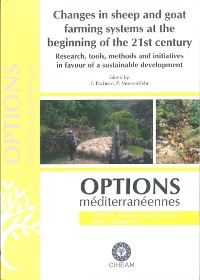| Article précédent | p. 245-248 | Article suivant |
Meat fatty acids profile of kid goats from Serpentina breed
The paper refers to the fatty acids (FA) profile of intramuscular fat in three muscle sites: longissimus dorsi (LD), leg, shoulder and the FA profile of perirenal fat (PRF). Kid goats were raised on three farms with distinct feeding management (1, 2 and 3) and slaughtered in December, at 10-12 kg live weight. From farm 3, intramuscular fat and PRF FA profile of kid goats slaughtered in April were compared to those from December. All goats grazed natural pastures and only goats and kids raised on farms 1 and 2 were supplemented. The saturated fatty acids (S) content was higher in PRF while the intramuscular fat of the different muscle samples showed a similar concentration of polyunsaturated fatty acids (P). Meat from kids raised on farm 3 and slaughtered in December was richer in conjugated linoleic acids, C18:2 cis9,trans11 (CLA) and in n-3 polyunsaturated fatty acids, with a dietetic advantage due to a lower n-6/n-3 fatty acids ratio. This result shows the advantage of a feeding system based only on pasture. Spring raised kids showed the same advantages in the FA profile: n-6/n-3 fatty acids ratio decreased from 2.25 to 1.60 and CLA increased from 0.45 to 0.66 percent, suggesting the higher quality of pastures during spring. A discriminant analysis using the FA profile of intramuscular fat of LD allowed the identification of the different feeding systems.
Cet article concerne le profil en acides gras (AG) du gras intramusculaire de trois muscles, Longissimus dorsi (LD), gigot, épaule, et le profil en AG du gras périrénal (GPR). Les chevreaux, issus de trois élevages (1, 2 et 3) ayant adopté une conduite alimentaire différente, furent abattus au mois de décembre, à un poids vif de 10-12 kg. Dans l'élevage 3, nous avons comparé le profil en AG du gras intramusculaire et du GPR des chevreaux abattus en avril et celui des chevreaux abattus en décembre. Toutes les chèvres ont été élevées sur pâturage naturel et seuls les chèvres et les chevreaux des élevages 1 et 2 ont reçu de la complémentation. Le niveau d'acides gras saturés (S) était plus élevé dans le GPR tandis que le gras intramusculaire des échantillons des différents muscles a présenté une concentration semblable en acides gras polyinsaturés (P). La viande des chevreaux de l'élevage 3 abattus en décembre était plus riche en acides linoléiques conjugués, C18 :2 cis9, trans11 (CLA) et en n-3-AG polyinsaturés, avec un avantage sur le plan diététique compte tenu du rapport acides gras n-6/n-3 plus bas. Ce résultat montre qu'un système d'alimentation basé sur le pâturage est plus avantageux. Les chevreaux élevés au printemps ont présenté les mêmes avantages pour ce qui est du profil en AG : le rapport acides gras n-6/n- 3 a baissé, passant de 2,25 à 1,60 et les CLA ont augmenté, passant de 0,45 à 0,66 pour cent, ce qui montre la qualité supérieure des pâturages au printemps. Une analyse discriminante utilisant le profil en AG du gras intramusculaire du LD a permis de différencier les trois systèmes d'alimentation.
- [ Afficher ]
- [ Télécharger ]
- [ Exporter la citation ]
Vous pouvez télécharger la citation au format :
- [ Imprimer ]
-
Mots-clés
ACIDE GRAS, CHEVREAU, PATURAGES, TECHNIQUE D'ALIMENTATION, VIANDE CAPRINECiter cet article
Belo A.T., Pereira M.S., Babo H., Belo C. Meat fatty acids profile of kid goats from Serpentina breed. In : Pacheco F. (ed.), Morand-Fehr P. (ed.). Changes in sheep and goat farming systems at the beginning of the 21st century : research, tools, methods and initiatives in favour of a sustainable development . Zaragoza : CIHEAM / DRAP-Norte / FAO, 2009. p. 245-248. (Options Méditerranéennes : Série A. Séminaires Méditerranéens; n. 91). Proceedings of the Seminar of the Subnetwork on Production Systems of the FAO-CIHEAM Network for Research and Development in Sheep and Goats, 2007/11/15-17, Ponte de Lima (Portugal). http://om.ciheam.org/om/pdf/a91/00801154.pdf



